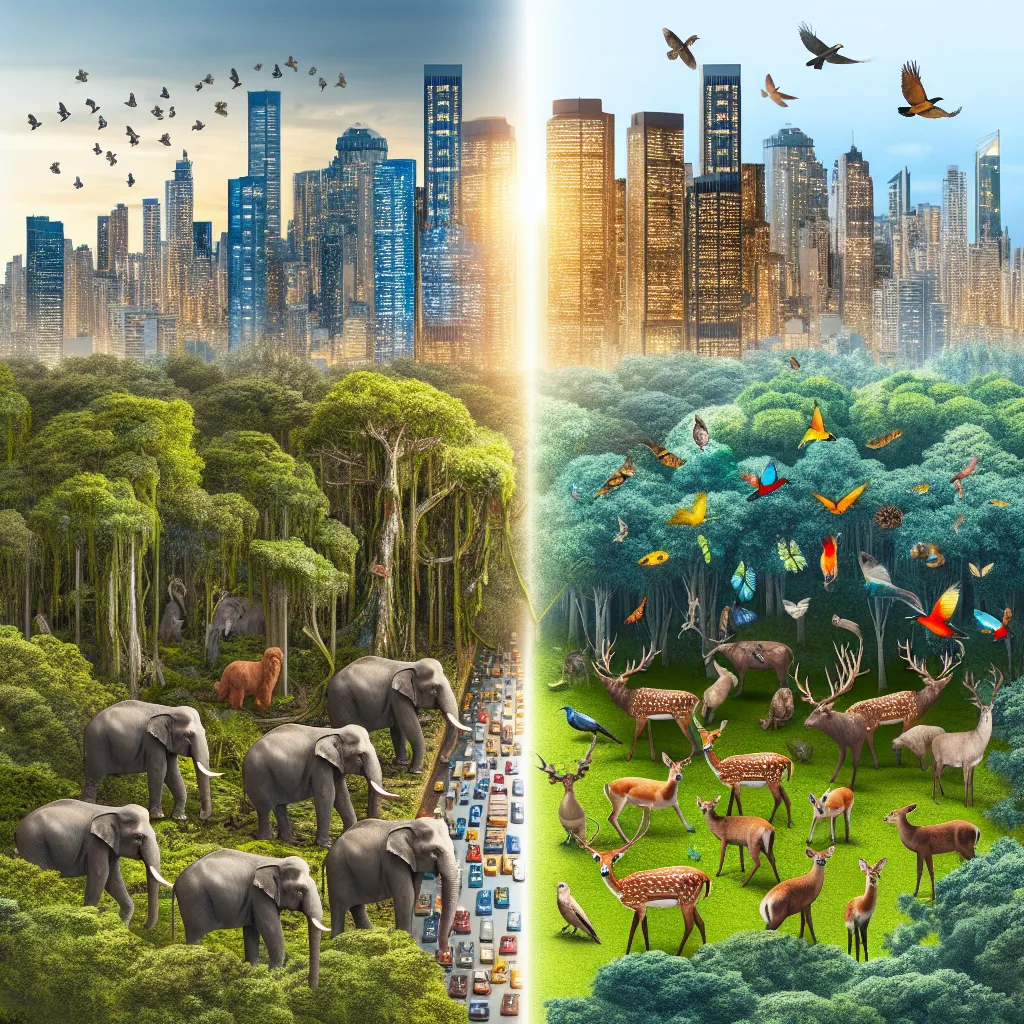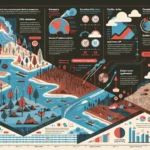The IELTS Reading section assesses your ability to comprehend complex texts and answer questions accurately. Today, we’ll focus on a topic that has been increasingly prevalent in recent years: “The impact of urbanization on wildlife.” This subject has appeared in various forms in past IELTS exams and remains highly relevant due to ongoing global urbanization trends. Given its importance in environmental studies and urban planning, there’s a strong likelihood that similar themes may resurface in future IELTS tests.
 Urban expansion affecting wildlife
Urban expansion affecting wildlife
Practice Test: The Impact of Urbanization on Wildlife
Reading Passage
As cities expand and human populations grow, the natural habitats of countless species are being encroached upon, leading to significant changes in wildlife behavior and population dynamics. This phenomenon, known as urbanization, is reshaping ecosystems worldwide and presenting both challenges and opportunities for various animal species.
One of the most noticeable impacts of urbanization on wildlife is habitat loss. As concrete jungles replace forests, grasslands, and wetlands, many animals find themselves displaced from their natural homes. This loss of habitat can lead to decreased biodiversity and, in some cases, local extinctions. Species that require large territories or specific environmental conditions are particularly vulnerable to these changes.
However, some animals have shown remarkable adaptability to urban environments. These “urban adapters” have learned to thrive in cities, often modifying their behavior to take advantage of new resources. For instance, raccoons in North American cities have become adept at opening garbage cans, while peregrine falcons have found that tall buildings make excellent substitutes for their natural cliff-side nesting spots.
The abundance of food waste in urban areas has led to changes in the diets of many animals. While this can benefit some species, leading to population booms, it can also have negative consequences. Urban wildlife often consumes foods that are nutritionally poor or even harmful, leading to health issues and altered natural behaviors.
Light pollution in cities has profound effects on nocturnal animals. Artificial lighting can disrupt natural circadian rhythms, affecting feeding patterns, reproduction, and migration. Some species, like sea turtles, can become disoriented by city lights, leading hatchlings away from the ocean instead of towards it.
Urbanization also creates barriers to animal movement. Roads, buildings, and other infrastructure can fragment habitats, isolating populations and impeding gene flow. This can lead to reduced genetic diversity and make species more vulnerable to extinction.
Despite these challenges, urban areas can also provide unexpected benefits for some wildlife. Parks and green spaces within cities can serve as important refuges, and some species have higher survival rates in urban areas due to reduced predation and increased food availability.
Conservation efforts in urban planning are becoming increasingly important. Wildlife corridors, green roofs, and urban wetlands are some of the innovative solutions being implemented to mitigate the negative impacts of urbanization on wildlife. These initiatives aim to create more wildlife-friendly cities that can coexist with nature rather than replace it.
In conclusion, the impact of urbanization on wildlife is complex and multifaceted. While it poses significant challenges for many species, it also presents opportunities for adaptation and coexistence. As we continue to expand our urban landscapes, it is crucial to consider the needs of wildlife and implement strategies that allow for the harmonious coexistence of humans and animals in our ever-growing cities.
Questions
True/False/Not Given
- Urbanization always leads to a decrease in biodiversity.
- Some animal species have adapted successfully to urban environments.
- Urban wildlife tends to have healthier diets compared to their rural counterparts.
- Light pollution affects only diurnal animals.
- Wildlife corridors are being used as a conservation strategy in urban areas.
Multiple Choice
-
According to the passage, which of the following is NOT mentioned as an impact of urbanization on wildlife?
A) Habitat loss
B) Changes in diet
C) Increased predation
D) Disruption of circadian rhythms -
The term “urban adapters” refers to:
A) City planners who design wildlife-friendly spaces
B) Animals that have successfully adapted to city life
C) Conservationists working in urban areas
D) Artificial structures that mimic natural habitats
Matching Information
Match the following effects with the correct cause from the passage:
- Fragmentation of habitats
- Disorientation of sea turtle hatchlings
- Higher survival rates for some species
Causes:
A) Reduced predation in urban areas
B) Artificial lighting in cities
C) Roads and buildings creating barriers
Short Answer Questions
-
Name two innovative solutions mentioned in the passage for creating wildlife-friendly cities. (No more than 5 words for each)
-
What specific skill have raccoons in North American cities developed? (No more than 6 words)
Answers and Explanations
-
False
Explanation: The passage states that urbanization can lead to decreased biodiversity, but it doesn’t say this always happens. Some species adapt and thrive in urban environments. -
True
Explanation: The passage mentions “urban adapters” that have learned to thrive in cities, giving examples like raccoons and peregrine falcons. -
False
Explanation: The passage states that urban wildlife often consumes nutritionally poor or harmful foods, leading to health issues. -
Not Given
Explanation: The passage only mentions the effects of light pollution on nocturnal animals. It doesn’t provide information about its impact on diurnal animals. -
True
Explanation: The passage explicitly mentions wildlife corridors as one of the innovative solutions being implemented in urban planning. -
C) Increased predation
Explanation: The passage mentions habitat loss, changes in diet, and disruption of circadian rhythms, but it actually states that some species have higher survival rates in urban areas due to reduced predation. -
B) Animals that have successfully adapted to city life
Explanation: The passage defines “urban adapters” as animals that have learned to thrive in cities. -
C) Roads and buildings creating barriers
Explanation: The passage states that “Roads, buildings, and other infrastructure can fragment habitats.” -
B) Artificial lighting in cities
Explanation: The passage mentions that “sea turtles can become disoriented by city lights.” -
A) Reduced predation in urban areas
Explanation: The passage states that “some species have higher survival rates in urban areas due to reduced predation.” -
Wildlife corridors, green roofs (Accept also: urban wetlands)
Explanation: These are directly mentioned in the passage as innovative solutions. -
Opening garbage cans
Explanation: The passage states that raccoons in North American cities “have become adept at opening garbage cans.”
Common Mistakes to Avoid
-
Overgeneralizing: Be cautious about statements that use absolute terms like “always” or “never.” The passage often presents a nuanced view of urbanization’s impacts.
-
Misinterpreting “Not Given”: Remember, if the passage doesn’t provide enough information to determine if a statement is true or false, the answer is “Not Given.”
-
Overlooking specific details: Pay attention to precise information, such as species names or specific adaptations mentioned.
-
Confusing cause and effect: Make sure you correctly identify which factor is causing a particular impact on wildlife.
Key Vocabulary
- Urbanization: /ˌɜːbənaɪˈzeɪʃən/ (noun) – the process of making an area more urban
- Encroach: /ɪnˈkrəʊtʃ/ (verb) – to gradually take away someone’s rights, land, etc.
- Biodiversity: /ˌbaɪəʊdaɪˈvɜːsəti/ (noun) – the variety of plant and animal life in a particular habitat
- Circadian rhythm: /sɜːˈkeɪdiən ˈrɪðəm/ (noun) – physical, mental, and behavioral changes that follow a 24-hour cycle
- Fragmentation: /ˌfræɡmənˈteɪʃən/ (noun) – the process of breaking something into small, isolated parts
Grammar Focus
Pay attention to the use of passive voice in scientific writing, for example:
- “Wildlife corridors, green roofs, and urban wetlands are being implemented…”
- “These initiatives aim to create more wildlife-friendly cities that can coexist with nature rather than replace it.”
This structure is common in academic and scientific texts to maintain an objective tone and focus on the action rather than the actor.
Tips for High Scores in IELTS Reading
-
Practice time management: Allocate your time wisely across all sections of the reading test.
-
Skim and scan effectively: Quickly identify key information without reading every word.
-
Pay attention to transition words: These can help you understand the relationship between ideas in the text.
-
Use the context: If you encounter unfamiliar words, try to deduce their meaning from the surrounding text.
-
Read the questions carefully: Ensure you understand exactly what each question is asking before searching for the answer.
-
Don’t rely on prior knowledge: Base your answers solely on the information provided in the passage.
-
Check your answers: If time permits, review your answers for any obvious mistakes.
Remember, consistent practice with a variety of text types and question formats is key to improving your IELTS Reading score. Focus on understanding the overall structure and main ideas of passages, as well as improving your ability to locate specific details quickly.
For more practice on environmental topics in IELTS Reading, you might find our article on the impact of urbanization on wildlife habitats helpful. Additionally, for strategies on tackling different question types, check out our guide on challenges of protecting wildlife in urban areas, which includes practice questions similar to those you might encounter in the actual test.


